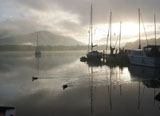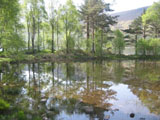|
|
Ullswater - a view from the Lake
A great deal of the land around Ullswater
is now National Trust property, the most notable being the Gowbarrow Fell
Estate and Glencoyne Wood. The Cumbria Trust For Nature Conservation
reserve at Goldrill Beck is not open to the public but can be seen from
the steamer and is a good example of alder carr and reed beds.
Ullswater has three reaches. At Pooley
Bridge the shores are pastoral, intermixed with woods coming down to the
lakeside. Up the lake from Pooley Bridge, rounded limestone land gives way
to banks of Skiddaw Slate, while past Skelly Nab the craggy heights of Borrowdale Volcanics can be seen with Helvellyn and Catstycam on
the high skyline with nearby Place Fell crowding the eastern shore. After
leaving Howtown, at the far end is Helvellyn with St. Sunday Crag on the
left. On the immediate right is Glencoyne and the well wooded Stybarrow
Crag descending into the lake. Opposite on the left is Place Fell which
descends almost to the water's edge. Kirkstone Pass is at the head of the
valley. In the middle reach the scenery becomes bolder and the fells rise
sheer out of the lake, whilst at Patterdale it is a picture of mountain
scenery.
Many miles of Ullswater's shore can be
enjoyed by car, but those wishing to explore the south eastern side of the
lake from Howtown to Patterdale must take to their feet. The steamers
"Raven" and "Lady of the Lake" sail regularly in summer between Glenridding
and Pooley Bridge calling at Howtown. The pleasures of sailing and walking
can be combined by boarding the steamer at Glenridding, disembarking at
Howtown and making the return journey on foot.
Oddly enough, Ullswater has trout but no char: one theory about the loss
of char is that the lower levels where char live were polluted by lead
from the mine spoils.
A Nature Panorama on Ullswater
Here is a description of the
beauty of the scenery and wildlife you will encounter as you journey on
Ullswater and as you walk in the area. This has been prepared by a
small group of members of the Cumbria Trust for Nature Conservation. The
Cumbria Wildlife Trust is a registered charity which exists to conserve
all forms of wildlife, both plant and animal, in Cumbria. Like other
county conservation trusts, it is a member of the Royal Society for Nature
Conservation.
To maintain the wide variety of plant and animal life, which
is an important part of Cumbria's attraction, the Trust is engaged in many
types of work. It establishes and manages nature reserves, advises local
authorities, public services, industry and agriculture on conservation
matters, carries out wildlife surveys, and promotes interest in the
countryside by nature trails, exhibitions, lectures and publications.
The
bulk of the Trust's income comes from members' subscriptions and from
donations. More is required if the Trust is to do the work necessary to
protect the wildlife and countryside of Cumbria. If you would like to help
conserve and develop the wildlife you have enjoyed in Cumbria, we'd
welcome your help in any form. You can get details here:
Wildlife Trust For
Cumbria
The Ullswater Navigation & Transit Company
Limited was formed in 1855 to provide a steamer service on Ullswater and
the steamers Lady of the Lake and Raven were launched in 1877 and 1889. In
those days the service provided a connection from Glenridding to Pooley
Bridge and carried the Royal Mail. Nowadays the same steamers provide an
opportunity to cruise the most beautiful of the English Lakes. The walker
and naturalist can take a single ticket from Glenridding to
Howtown and return on foot along the lake shore.
Ullswater is considered by many to be the
most beautiful of the English lakes.
It is 7.5 miles long in three
reaches. At its head are the high fells with the Helvellyn massif on one
side and High Street on the other, and its foot in the pastoral vale of
the river Eamont which is its outflow.
Patterdale (St. Patrick's Dale) is the village at the head of the lake and
close by is Glenridding with its pier from which the steamers Raven and
Lady of the Lake ply to and from Pooley Bridge at the lake's foot, calling
at Howtown on the eastern shore. From Glenridding there are several routes
up on to Helvellyn.
A mile and a half west of Glenridding, on the way up on to Helvellyn, is
the old Greenside Mine which finally closed after the last war. Galena was
the chief ore, yielding about 80% lead and a little silver. The chalice in
the church is made from Glenridding silver.
High above Patterdale and to the east is Angle Tarn in a wild upland
setting. About a mile north of the tarn and at the top of the steep climb
from Patterdale, tracks lead down Boardale and nearby Bannerdale and also
along the ridge of Beda Fell into Martindale and Howtown for the steamer
back to Glenridding.
Howtown gives access to Martindale with its parish church of St. Peter on
the hawse at the top of the hairpin bends, and half a mile further on, in
the Howegrain valley, the older (thirteenth century) church of St. Martin
and its 500 year old yew tree. Facing St. Peter's church is Hallin Fell,
well worth the climb for the splendid views of lake and fells from the
summit. Martindale is the home of the last herd of wild red deer in
England. Sightings are most likely in the area of the Nab in the Howegrain
and Bannerdale valleys and towards High Street.
A footpath goes along the eastern shore from Howtown to Patterdale via
Kailpot Crag, Hallinhag Wood (one of the few remaining woodlands of
the kind which once clothed all but the highest tops), Sandwick, Scalehow
Beck, Silver Point and Side Farm. Roughly half way between Kailpot Crag
and Silver Point is the deepest part of the lake - 205 ft. You can take
the steamer from Glenridding to Howtown and walk back to Patterdale along
this lovely path by the lake through ancient woodland, meadows and
juniper-covered hillside.
South of Patterdale the road goes by Hartsop village and Brotherswater and
over the Kirkstone Pass to Windermere and Ambleside.
Following the northwest side of the lake towards its foot at Pooley
Bridge, the road winds through woodland by Stybarrow Crag and on to
Glencoyne Manor Farm with its typical cylindrical seventeenth century
Lakeland-style chimneys. The farm is a National Trust property of some
4,500 acres of fell land for sheep and hill cattle, and in summer open
days are held for visitors to learn something of the working of a Lakeland
sheep farm.
On now to Aira Force, a spectacular waterfall 65ft. high on the lower part
of Aira Beck which drains some of the Helvellyn range. This is also a
National Trust property. Nearby are Lyulph's Tower mentioned by Coleridge,
and the lakeside where Wordsworth saw his host of golden daffodils or
"Lenten lilies" as the wild daffodils are sometimes called.
Geologically, the Ullswater region comprises two main formations: the
Skiddaw Slates and the Borrowdale Volcanic series. These frequently
intermingle and result in the mixture of crags and open plateaux which
contrast with the gentler slopes running down to the edge of the lake.
Ullswater is fed by many waters, some from Kirkstone to the south through
Brotherswater are joined by water from Dovedale, Deepdale, Grisedale,
Caudale and Hayeswater. Helvellyn sends its quota of fast flowing waters.
The water from Aira Beck, failing down the crag face at Aira Force, joins
the middle reaches, and the waters from Boardale, Bannerdale and Fusedale
flow in from the southern remoteness of Martindale. It is little wonder
that at times Ullswater floods its banks. In 1961 Manchester Corporation
Waterworks Department promoted a Parliamentary Bill to turn Ullswater into
a reservoir, but the bill was defeated by the eloquence of Lord Birkett in
the House of Lords in February 1962. Lord Birkett died soon afterwards,
but in gratitude for his efforts, a fell was named after him. This is on
the western side of the take above Glencoyne Head. There is also a plaque
to his memory on Kailpot Crag, but this is only visible from a boat.
Later, the Water Authority was allowed to abstract limited quantities of
water.
A walk along Ullswater by lake and shore
Howtown - Patterdale
Howtown
The small headland on which the Howtown steamer pier stands is formed by
debris (stones, gravel, sand and silt) washed down by the waters of
Fusedale Beck. This material is deposited at the outflow of the beck to
form a delta which is colonised first by water loving plants such as
sedges and mosses which stabilise the land and thus pave the way for dry
land species to move in. Fusedale Beck is crossed by a wooden footbridge
overhung by alders. In spring lesser celandines, primroses and the
green-flowered dog's mercury grow here, followed by wood anemones, marsh
marigolds and later still common valerian. In early summer the meadow near
the shore has a rich and varied flora including yellow rattle, betony,
wood cranesbill and lady's bedstraw.
Hallin Fell
In spring the grassy slopes and rocky outcrops on Hallin Fell provide
nesting sites for meadow pipit and wheatear and the grass is starred with
the small yellow of tormentil. In summer the fell becomes a sea of waist
high bracken relieved by patches of bright pink foxgloves. From here there
is a fine view down the lake to Dunmallet Hill.
Hallinhag Wood
Hallinhag Wood is an example of natural woodland. The dominant tree is the
oak but there are others including rowan, Scots pine and some fine
beeches, though the latter were probably planted. Some trees are draped
with honeysuckle and the woodland floor is carpeted with mosses and the
rocks patched with lichens. There are many ferns, and wood sage and wood
sorrel grow in the more open areas. The ancient trees provide abundant
holes and crevices for woodland birds to nest. Greater spotted woodpecker,
pied flycatchers, tree creepers, great tits and blue tits all breed here.
Kailpot Crag
The conspicuous outcrop of rock is Kailpot Crag. It takes its name from a
pothole at its base formed by the swirling action of stones and water in a
depression. This is difficult to see as the crag drops sheer to the lake
and the pot can only be reached by scrambling round the shoreline.
Sandwick
A row of fine larches borders the path which leads to the bridge over
Boardale Beck and the hamlet of Sandwick. Golden saxifrage, pink purslane,
and marsh marigold grow by the beck.
The Sandwick area is of great interest to the geologist. Most of the walk
is over rocks of the Borrowdale volcanic type giving the hills a rough
craggy character. Between Hallinhag Wood and Scalehow Wood however the
underlying rock is Skiddaw Slate and the hills are smoother and rounder.
The waterfall on Scalehow Beck drops over the fault where the Skiddaw
state and Borrowdale volcanic rocks meet. In wet flushes here the
buttercup like flowers of lesser spearwort and the insectivorous plants of
round leaved sundew and butterwort can be found.
Scalehow Wood
Scalehow Wood is surrounded by a wall but redstarts, spotted flycatchers
and coal tits can often be seen flitting through the edge of the wood. In
early summer a bird cherry just outside the wall is often infested with
the communal webs of the small ermine moth caterpillar.
Long Crag
Bracken is the dominant vegetation above Scalehow Wood but at long Crag we
are back on Borrowdale volcanic rock. Above the path are steep scree
slopes and these continue below the path to the lake's edge. From here
there are fine views across the lake to Gowbarrow, Aira Point and Lyulph's
Tower, a hunting lodge built in the 19th century. The name Ullswater is
said to be a corruption of Lyulph's Water. Aira Point is a delta formed
from debris brought down by the Aira Beck.
Low Birk Fell
Parsley fern grows between the rocks on Low Birk Fell thus helping to
stabilise the scree. Trees too, mainly birch, find a foothold amongst the
rocks.
Birk Fell Earth
The slopes here are fairly well wooded mainly with birch and juniper but
there are others including rowan and near to the water's edge alder and
willow. Bracket fungus be seen on some of the birch trees. This fungus
leads to the decay and eventual death of the trees. The elegant yellowish
green ferns rather like enormous shuttlecocks are scaly male ferns.
Violets flower here in the spring and the tiny flowers of milkwork, some
almost pure white, some deepest blue. Here too are herb robert and lady's
mantle.
Silver Point
A small stream flowing between banks of juniper from Silver Crag marks the
change from woodland to more open fellside and Silver Point. This is a
pleasant place to linger and enjoy the views back down the middle reach of
the lake and across to Glencoyne and Stybarrow Crag. House Holm Island and
the promontory of Devil's Chimney are popular resting places for
cormorants. Some mature holly trees grow on the lower slopes of Silver
Crag and holly blue butterflies are attracted to the flowers in May.
Silver Crag to Side Farm
In this section of the walk the path is mainly between walls but interest
is maintained by the great variety of trees.
Side Farm to Patterdale
The way here is through pasture fields and over Goldrill Beck. Lapwings
nest in the fields and pied and yellow wagtails frequent the beck.
Birds
The area is rich in bird life. As well as those already mentioned,
yellowhammers, greenfinches, chaffinches, willow warblers and jays may be
encountered. Great rafts of gulls roost on the lake and the bays are
frequented by mallard, merganser, coot and herons.
Fish
An interesting fish found in the lake is the Schelly. A type of powan it
is found in only two other lakes, Haweswater and Red Tarn. It is supposed
that it was isolated in these lakes shortly after the ice age and has
developed slight differences from its relatives in lakes in other parts of
Britain. Trout and perch also inhabit the lake.
More on
Ullswater
|
 |


